#and Security-Regolith Explorer
Explore tagged Tumblr posts
Text
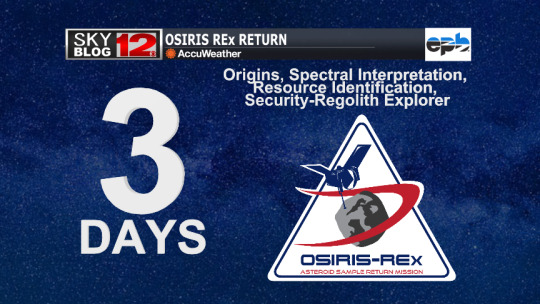
"NASA is inviting the public to take part in virtual activities ahead of the OSIRIS-REx (Origins, Spectral Interpretation, Resource Identification, and Security-Regolith Explorer) asteroid sample return mission. Members of the public can register to attend the sample return virtually."
#OSIRIS-REx#Origins#Spectral Interpretation#Resource Identification#and Security-Regolith Explorer#asteroid sample return
0 notes
Video
OSIRIS-REx Sample Return (NHQ202309240001) by NASA HQ PHOTO Via Flickr: The sample return capsule from NASA’s OSIRIS-REx mission is seen shortly after touching down in the desert, Sunday, Sept. 24, 2023, at the Department of Defense's Utah Test and Training Range. The sample was collected from the asteroid Bennu in October 2020 by NASA’s OSIRIS-REx spacecraft. Photo Credit: (NASA/Keegan Barber)
#Asteroid Sample Return#Origins Spectral Interpretation Resource Identification Security-Regolith Explorer (OSIRIS-REx)#Utah#Utah Test and Training Range#Origins Spectral Interpretation Resource Identification Security#Dugway#UT#NASA#Keegan Barber#flickr
1 note
·
View note
Text
Touchdown! Alien Rock Returned from Billions of Miles Away!

After traveling billions of miles to Bennu and back, the OSIRIS-REx spacecraft released its sample capsule toward Earth’s atmosphere at 6:42 a.m. EDT (4:42 a.m. MDT). The spacecraft was 63,000 miles (102,000 kilometers) from Earth’s surface at the time – about one-third the distance from Earth to the Moon.
Traveling at 27,650 mph (44,500 kph), the capsule pierced the atmosphere at 10:42 a.m. EDT (8:42 a.m. MDT), off the coast of California at an altitude of about 83 miles (133 kilometers). Within 10 minutes, it landed on the military range. Along the way, two parachutes successfully deployed to stabilize and slow the capsule down to a gentle 11 mph (18 kph) at touchdown
“The returned samples collected from Bennu will help scientists worldwide make discoveries to better understand planet formation and the origin of organics and water that led to life on Earth, as well as benefit all of humanity by learning more about potentially hazardous asteroids”
After years of anticipation and hard work by NASA’s OSIRIS-REx (Origins, Spectral Interpretation, Resource Identification and Security – Regolith Explorer) team, a capsule of rocks and dust collected from asteroid Bennu finally is on Earth. It landed at 8:52 a.m. MDT (10:52 a.m. EDT) on Sunday, in a targeted area of the Department of Defense’s Utah Test and Training Range near Salt Lake City.
Within an hour and a half, the capsule was transported by helicopter to a temporary clean room set up in a hangar on the training range, where it now is connected to a continuous flow of nitrogen.
Getting the sample under a “nitrogen purge,” as scientists call it, was one of the OSIRIS-REx team’s most critical tasks today. Nitrogen is a gas that doesn’t interact with most other chemicals, and a continuous flow of it into the sample container inside the capsule will keep out earthly contaminants to leave the sample pure for scientific analyses.
76 notes
·
View notes
Text

NASA to gather in-flight imagery of commercial test capsule re-entry
A NASA team specializing in collecting imagery-based engineering datasets from spacecraft during launch and reentry is supporting a European aerospace company's upcoming mission to return a subscale demonstration capsule from space.
NASA's Scientifically Calibrated In-Flight Imagery (SCIFLI) team supports a broad range of mission needs across the agency, including Artemis, science missions like OSIRIS-REx (Origins, Spectral Interpretation, Resource Identification, and Security—Regolith Explorer), and NASA's Commercial Crew Program. The SCIFLI team also supports other commercial space efforts, helping to develop and strengthen public-private partnerships as NASA works to advance exploration, further cooperation, and open space to more science, people, and opportunities.
Later this month, SCIFLI intends to gather data on The Exploration Company's Mission Possible capsule as it returns to Earth following the launch on a SpaceX Falcon 9 rocket. One of the key instruments SCIFLI will employ is a spectrometer that detects light radiating from the capsule's surface, which researchers can use to determine the surface temperature of the spacecraft.
Traditionally, much of this data comes from advanced Computational Fluid Dynamics modeling of what happens when objects of various sizes, shapes, and materials enter different atmospheres, such as those on Earth, Mars, or Venus.
"While very powerful, there is still some uncertainty in these Computational Fluid Dynamics models. Real-world measurements made by the SCIFLI team help NASA researchers refine their models, meaning better performance for sustained flight, higher safety margins for crew returning from the moon or Mars, or landing more mass safely while exploring other planets," said Carey Scott, SCIFLI capability lead at NASA's Langley Research Center in Hampton, Virginia.
The SCIFLI team will be staged in Hawaii and will fly aboard an agency Gulfstream III aircraft during the re-entry of Mission Possible over the Pacific Ocean.
"The data will provide The Exploration Company with a little bit of redundancy and a different perspective—a decoupled data package, if you will—from their onboard sensors," said Scott.
From the Gulfstream, SCIFLI will have the spectrometer and an ultra-high-definition telescope trained on Mission Possible. The observation may be challenging since the team will be tracking the capsule against the bright daytime sky.
Researchers expect to be able to acquire the capsule shortly after entry interface, the point at roughly 200,000 feet, where the atmosphere becomes thick enough to begin interacting with a capsule, producing compressive effects such as heating, a shock layer, and the emission of photons, or light.
In addition to spectrometer data on Mission Possible's thermal protection system, SCIFLI will capture imagery of the parachute system opening. First, a small drogue chute deploys to slow the capsule from supersonic to subsonic, followed by the deployment of a main parachute. Lastly, cloud-cover permitting, the team plans to image splashdown in the Pacific, which will help a recovery vessel reach the capsule as quickly as possible.
If flying over the ocean and capturing imagery of a small capsule as it zips through the atmosphere during the day sounds difficult, it is. But this mission, like all SCIFLI's assignments, has been carefully modeled, choreographed, and rehearsed in the months and weeks leading up to the mission. There will even be a full-dress rehearsal in the days just before launch.
Not that there aren't always a few anxious moments right as the entry interface is imminent and the team is looking out for its target. According to Scott, once the target is acquired, the SCIFLI team has its procedures nailed down to a—pardon the pun—science.
"We rehearse, and we rehearse, and we rehearse until it's almost memorized," he said.
The Exploration Company, headquartered in Munich, Germany, and Bordeaux, France, enlisted NASA's support through a reimbursable Space Act Agreement and will use SCIFLI data to advance future capsule designs.
"Working with NASA on this mission has been a real highlight for our team. It shows what's possible when people from different parts of the world come together with a shared goal," said Najwa Naimy, chief program officer at The Exploration Company.
"What the SCIFLI team is doing to spot and track our capsule in broad daylight, over the open ocean, is incredibly impressive. We're learning from each other, building trust, and making real progress together."
NASA Langley is known for its expertise in engineering, characterizing, and developing spacecraft systems for entry, descent, and landing. The Gulfstream III aircraft is operated by the Flight Operations Directorate at NASA's Armstrong Flight Research Center in Edwards, California.
IMAGE: A rendering of a space capsule from The Exploration Company re-entering Earth’s atmosphere. Credit: The Exploration Company
4 notes
·
View notes
Text
Moon Day





(All of my moon pics from my photo gallery)
On July 20, 2024, I set up Moon Base Alpha, a stable habitat for their lunar mission. I worked diligently to establish a secure living and working environment, ensuring all life support systems were functioning perfectly. I embarked on an exploration mission around the landing site, collecting samples of lunar regolith and rocks to uncover secrets about the moon's history.
The solar panel deployment was crucial for ensuring a sustainable power source, as it unfurled effortlessly, soaking up abundant sunlight. During my exploration, I discovered an unusual rock formation with crystalline structures, which could be a rare type of lunar mineral. Subsurface ice deposits were also discovered, providing a vital resource for water and oxygen.
Despite challenges, such as a communication glitch with Mission Control and the pervasive lunar dust, I was able to resolve the issue and re-establish contact. The pervasive lunar dust caused minor visibility issues and concerns about its impact on machinery. I will need to devise better strategies to mitigate its effects in the coming days.
As I settle into my sleeping pod, gazing out at the desolate beauty of the lunar surface, I am filled with a profound sense of wonder and gratitude. Today marked the beginning of my lunar adventure, and I'm eager to see what tomorrow holds. The moon holds many mysteries, and I'm here to uncover them, one small step at a time.
4 notes
·
View notes
Photo
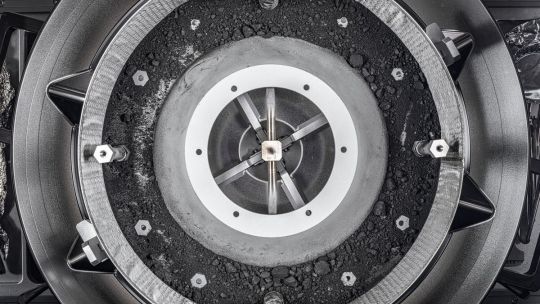
1st look at asteroid Bennu samples suggests space rock may be 'a fragment of an ancient ocean world' | Space
'We're going to be busy for a long, long time. This is an enormous amount of sample for us.’
Scientists are now inspecting snagged, bagged and tagged bits and pieces from asteroid Bennu, the cosmic mother lode delivered by NASA's Origins, Spectral Interpretation, Resource Identification and Security — Regolith Explorer mission.
Known in acronymic astro-speak as OSIRIS-REx, that seven-year-long voyage brought home the goods via a sample return canister that came to full stop on Sept. 24, 2023, parachuting into a remote stretch of the Department of Defense's Utah Test and Training Range. Those specimens from afar are believed to contain the leftovers from the formation of the solar system 4.5 billion years ago.
Space.com caught up with two leading scientists now engaged in extracting what those darkish asteroid particles are illuminating, sorting out how these materials exported from Bennu came to be. But also what insights they hold for the origin of the worlds within our solar system, including Earth. ...
4 notes
·
View notes
Link
It’s been another great year at NASA’s Ames Research Center in California’s Silicon Valley. Join us as we review some of the highlights of the science, engineering, and innovation from 2023. Announcing a New Innovation Hub Planned for NASA Research Park at Ames NASA Berkeley Space Center is a proposed new campus of the University of California, Berkeley, and an innovation hub for research and advances in astronautics, aeronautics, quantum computing, climate studies, and more. Planning to join Ames as a tenant of our NASA Research Park in Silicon Valley, the new campus aims to bring together researchers from the private sector, academia, and the government to tackle the complex scientific, technological, and societal issues facing our world. Mapping Water Distribution on the Moon’s South Pole NASA Using data collected by the now-retired Stratospheric Observatory for Infrared Astronomy (SOFIA), researchers shared the first detailed, wide-area map of water distribution on the Moon. Understanding how much water lies beneath the lunar surface, and how it’s distributed, will help guide future missions like VIPER, as well as prospective sites for human habitats. Colliding Moons May Have Formed Saturn’s Rings NASA New research suggests Saturn’s icy moons and rings were formed by a collision a few hundred million years ago, creating debris that gathered into the planet’s dusty, icy rings or clumped together to form moons. NASA and Airlines Partner to Save Fuel and Reduce Delays NASA/James Blair This year, NASA partnered with five major U.S. airlines on an air traffic decision-making tool that saved more than 24,000 pounds of jet fuel in 2022 for flights departing from Dallas-Fort Worth International Airport and Dallas Love Field Airport. Partners include American Airlines, Delta Air Lines, JetBlue Airways, Southwest Airlines and United Airlines. NASA Leaders View Climate Science, Wildfire Innovations at Ames NASA/Dominic Hart NASA’s top leadership, industry experts, and legislative officials visited Ames in April to learn about about the center’s climate science efforts and innovations in aeronautics that will help scientists and engineers better understand climate change and mitigate natural disasters like wildland fires. Starling Takes Flight Blue Canyon Technologies/NASA In July NASA’s Starling mission, managed at Ames, launched four CubeSats into low-Earth orbit to test robotic swarm technologies for space. You can track mission milestones via the Small Satellite Missions blog, and follow the mission live in NASA’s Eyes on the Solar System 3D visualization. NASA’s First Robotic Moon Rover NASA/Robert Markowitz This year engineers began assembling NASA’s first robotic Moon rover, VIPER — short for the Volatiles Investigating Polar Exploration Rover — and the agency is giving the public a front row seat to watch along as the rover takes shape. While individual components, such as the rover’s science instruments, lights, and wheels, were assembled and tested, the VIPER team also completed software development, mission planning, and tricky tests of the rover’s ability to drive off the Astrobotic Griffin lunar lander and onto the lunar surface. Bringing Home Ancient Space Rocks NASA/Keegan Barber NASA’s OSIRIS-REx mission – short for the Origins, Spectral Interpretation, Resource Identification, and Security-Regolith Explorer – returned to Earth in Sept. 2023, bringing with it extraterrestrial rocks and dust that it scooped up from an asteroid estimated to be 4.5 billion years old. Ames contributed to the spacecraft’s heat shield, anti-contamination systems, post-landing sample curation, and more. Preparing to Send Yeast to the Moon’s Surface for Astronaut Health NASA/Dominic Hart NASA’s plans to explore the Moon and eventually go to Mars will bring humans deeper into space for longer duration missions than ever before. These extended missions beyond low Earth orbit pose certain health risks to astronauts. The Lunar Explorer Instrument for Space Biology Applications team is preparing an experiment to study yeast’s biological response to the lunar environment to help understand and mitigate health risks for astronauts. X-59 Team Moves Toward First Flight in 2024 Lockheed Martin/Gary Tice This year, NASA’s X-59 team installed the finishing touches to the aircraft’s tail structure and moved it from its assembly facility to the flight line to perform structural testing. The X-59 quiet supersonic aircraft will take its first flight in 2024. Celebrating a Stellar Year for Webb Telescope Science NASA, ESA, CSA, STScI, and S. Crowe (University of Virginia) The James Webb Space Telescope’s Near-Infrared Camera instrument produced a feast for the eyes with a view into a star-forming region, named Sagittarius C, in the heart of the Milky Way. The image reveals a portion of the dense center of our galaxy in unprecedented detail, including never-before-seen features astronomers have yet to explain. Supercomputer Simulations Lead to Air and Space Innovations NASA Simulations and models developed using technology at the NASA Advanced Supercomputing Facility (NAS) help researchers and engineers develop innovations in air and space. Modeling turbofan engines could lead to designs that reduce engine noise and improve efficiency by understanding where noise is generated inside the machine. S-MODE Sails the Seas and Soars through the Sky NASA/Avery Snyder The Sub-Mesoscale Ocean Dynamics Experiment (S-MODE) logged its final field expedition, and they took a team from the TODAY Show along for the ride. S-MODE combined airborne instruments, research ships, and autonomous ocean gliders to get an unprecedented look at how gas and heat exchange at the ocean’s surface impacts Earth’s climate. From Intern to Astronaut, and Back to Ames NASA/Dominic Hart NASA astronaut Jessica Watkins, who was once an intern at Ames, returned to the Bay Area in Feb. 2023 to visit with local elementary schools and speak with Ames employees. Watkins started her career with NASA at Ames, where she conducted research on Mars soil simulant supporting the Phoenix Mars Lander mission. Second Gentleman Joins East Bay Kids for STEM Activities NASA/Dominic Hart Nearly 100 East Bay kids and their families got to experience the thrill of “launching a rocket” and “making clouds” at a fun-filled STEM event hosted in honor of Women’s History Month at the East Oakland Youth Development Center in Oakland, California, in March 2023. Second Gentleman Douglas Emhoff, NASA Ames Research Center Director Dr. Eugene Tu, and NASA astronaut Dr. Yvonne Cagle joined kids at the Manzanita Community School for hands-on activities and to distribute approximately 500 STEM Artemis Learning Lunchboxes aimed to inspire the Artemis generation to learn about NASA’s Artemis Program. Top Leaders in Our Midst Hailed from the White House and Australia NASA/Dominic Hart In January, U.S. President Joe Biden landed at Moffett Federal Airfield, at Ames, on his way to visit storm-damaged regions in the state. Research conducted at our Silicon Valley center could help predict extreme climate-related weather events. Later in the spring, Vice President Kamala Harris arrived at Moffett before delivering remarks at a local company, and leaders of the Australian Space Agency visited Ames to learn about the center’s missions supporting NASA’s Artemis program, including the VIPER Moon rover, which will launch to the lunar South Pole in late 2024.
2 notes
·
View notes
Text
Initial studies of the 4.5-billion-year-old asteroid Bennu sample collected in space and brought to Earth by NASA show evidence of high-carbon content and water, which together could indicate the building blocks of life on Earth may be found in the rock. NASA made the news Wednesday from its Johnson Space Center in Houston where leadership and scientists showed off the asteroid material for the first time since it landed in September.
This finding was part of a preliminary assessment of NASA’s OSIRIS-REx (Origins, Spectral Interpretation, Resource Identification and Security – Regolith Explorer) science team.
“The OSIRIS-REx sample is the biggest carbon-rich asteroid sample ever delivered to Earth and will help scientists investigate the origins of life on our own planet for generations to come,” said NASA Administrator Bill Nelson. “Almost everything we do at NASA seeks to answer questions about who we are and where we come from. NASA missions like OSIRIS-REx will improve our understanding of asteroids that could threaten Earth while giving us a glimpse into what lies beyond. The sample has made it back to Earth, but there is still so much science to come – science like we’ve never seen before.”
Although more work is needed to understand the nature of the carbon compounds found, the initial discovery bodes well for future analyses of the asteroid sample. The secrets held within the rocks and dust from the asteroid will be studied for decades to come, offering insights into how our solar system was formed, how the precursor materials to life may have been seeded on Earth, and what precautions need to be taken to avoid asteroid collisions with our home planet.
3 notes
·
View notes
Text
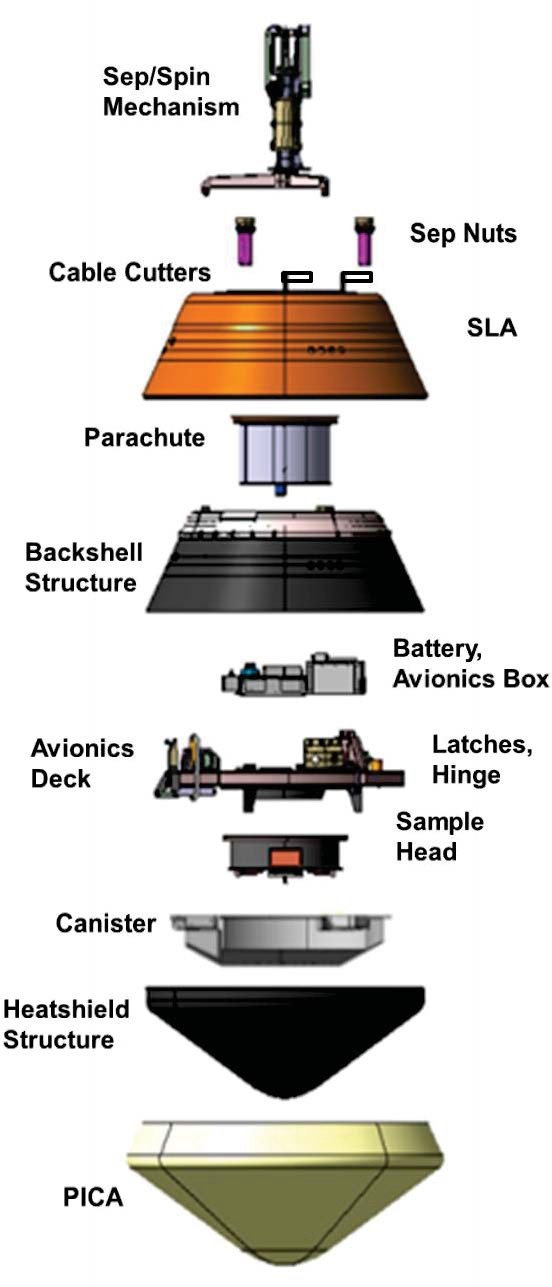
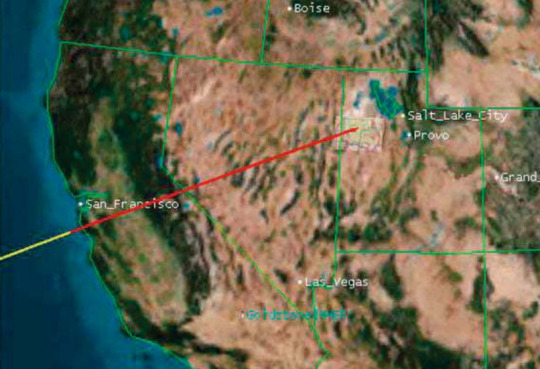
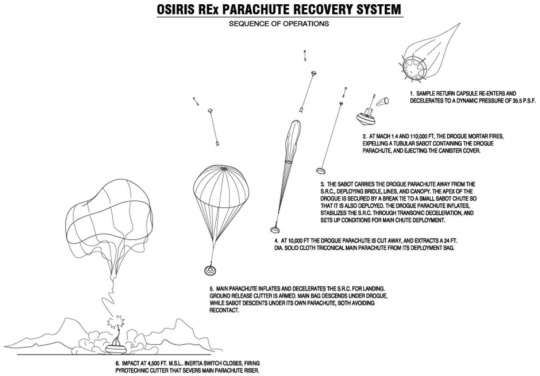
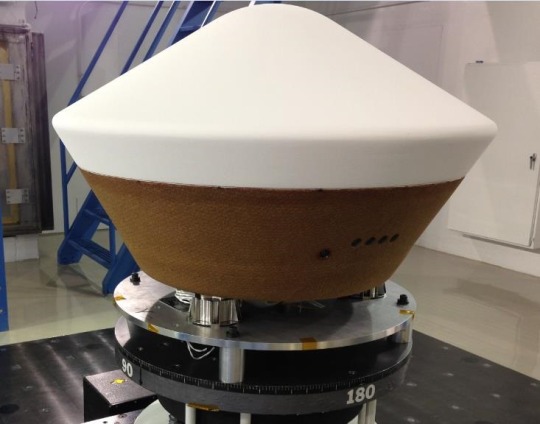
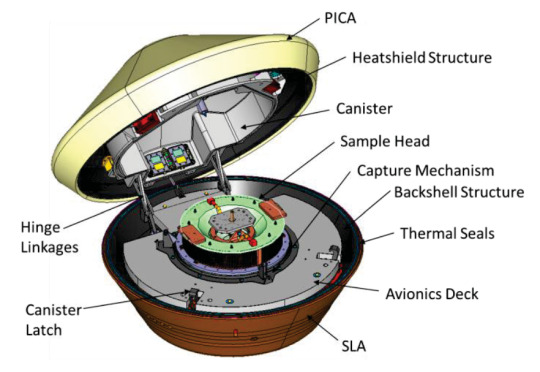
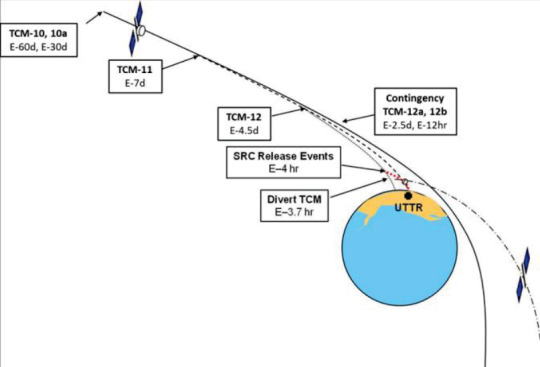

The Sample Return Capsule (SRC) will land today in the Utah Test and Training Range, south west of Utah City.
The OSIRIS Rex (Origins, Spectral Interpretation, Resource Identification, Security, Regolith Explorer) will release the SRC capsule at 11:42 BST (the spacecraft itself will then fire its engine to avoid Earth at 12:02 BST to fly-by at a distance of 485mi so it can continue on another mission). The SRC capsule will enter the Earths atmosphere at 15:42 BST at 12km/sec (feature than an Apollo/Orion reentry from the Moon) and will experience a deceleration of some 32g.
11:42BST (04:42MDT) E-04:00:00 SRC release
12:02 (05:02) E-03:07:00 OSIRIS Rex divert TCM burn (flyby 485mi)
15:00 (08:00) LANDING COVERAGE NASA TV
15:42 (08:42) 14:38:28UT E-0 Entry Interface
E+00:00:51 Maximum heating
E+00:00:61 Maximum G (31.8G)
* At 110,000ft and mach 1.4 drogue chute mortor fires. ejecting the canister cover and expelling a tubular sabot containing the drogue chute.
* Sabot chute deploys pulling out bridle, lines and canopy of drogue chute
E+00:02:25 Drogue Chute Deploy
* Drogue chute inflates, sabot and its chute detach via break tie
* 10,000ft drogue chute detach pulling out 24ft diameter main parachute from its deployment bag
E+00:07:06 Main Chute Deploy
* Main chute inflatesE+00:13:05 Touchdown
Pyrotechnic cutter severs main parachute riser
The recovery team will arrive in four helicopters, first a Lockheed Martin safety engineer will approach the capsule and measure the capsules temperature remotely to ascertain if it is safe to approach, next the atmosphere will be sampled and the area around the capsule will be inspected for any potential hazards.
Them a team from the University of Arizona lead by Principle Investigator Dante Lauretta will cordoned off the area around the Sample Return Capsule (SRC) with flags to denote a keep-out zone and then conduct environmental sampling in that area to build up a library of anything, air, soil, organic matter etc, which could possibly have contaminate the asteroid samples during the landing and recovery.
Once the capsule, weighing 45kg (100 lb), is ready for transport it will be lifted by two people into a metal transport crate and wrapped in multiple layers of Teflon and a tarpaulin. Next the wrapped crate will be fitted with a cargo harness and secured to a lift cable.
This will be attached to a hired Bell Jet Ranger helicopter (in rehearsal's anyway), as a slung load and flown to a hanger at Hill Air Force Base (the range HQ) equipped with a clean room (tent like structure in this case).
There the capsule will be opened and the sample canister will be extracted. The day after both the sample canister and the capsule will be flown to NASA’s Johnson Spaceflight Centre in Houston for storage and from there the sample will be divided and distributed to science investigator teams around the world.
Coverage on NASA TV from 3pm BST (10:00am EDT)... (the picture of the capsule under a parachute is from the recovery rehearsal conducted on 23 August 2023 which was dropped from a helicopter fro the rehearsal)
2 notes
·
View notes
Video
youtube
Drinking Water in Space: A Vital Challenge for Astronauts One of the most fundamental necessities for human survival is water. On Earth, we have the luxury of abundant water sources, but in space, obtaining and maintaining safe drinking water is a major challenge. Astronauts living aboard the International Space Station (ISS) or planning future missions to the Moon and Mars must deal with unique obstacles to ensure a sustainable water supply. Why Is Water So Crucial in Space? Water serves multiple purposes in space beyond hydration. It is used for food preparation, personal hygiene, and even generating oxygen through electrolysis. Additionally, maintaining the body’s fluid balance is crucial in the microgravity environment of space, where fluids tend to shift toward the upper body. Dehydration and fluid imbalance can lead to severe health issues, affecting mission success. The Challenges of Obtaining Water in Space Transporting water from Earth to space is not practical for long-term missions due to the immense cost and weight. Therefore, innovative methods are required to recycle and conserve water efficiently. One of the primary techniques used aboard the ISS is the Water Recovery System (WRS), which recycles wastewater from urine, sweat, and cabin humidity. This system can reclaim up to 93% of water, making it an essential component of the ISS's life support system. Water Recycling Techniques The WRS uses filtration, distillation, and chemical purification to turn wastewater into potable water. Initially, water is distilled to remove impurities, followed by filtration to eliminate contaminants. Finally, chemical additives ensure that the recycled water is safe to drink. Advanced microbial checks and sensor technologies constantly monitor the water quality. Future Water Solutions for Deep Space Missions Future missions to the Moon and Mars demand even more efficient water management strategies. NASA and other space agencies are researching ways to extract water from lunar and Martian regolith. Additionally, 3D-printed filtration systems and algae-based water purification are under consideration. Innovations like these are crucial to achieving long-duration missions without relying on Earth-based resupply. Conclusion The quest for sustainable water in space is an ongoing challenge that necessitates cutting-edge technology and continuous innovation. As humanity ventures further into the cosmos, finding reliable ways to secure and manage drinking water remains a top priority. #DrinkingWater #SpaceExploration #WaterRecycling #NASA #ISSMissions #SpaceLife #AstronautHealth #SpaceTechnology #WaterInSpace #SustainableWater #SpaceChallenges #raaganilavu #രാഗനിലാവ് #RNM #RaagaNilavu #രാഗനിലാവ് #rnmsocialmedia #MalayalamNews #MalayalamLive #sbtrendz #sbtrendzhealth #sbtrendznaturals #sbtrendzonline #newgadgets #dabspaints #hometrekkerindia #Malayalamlive #bazznjazz #SpaceInnovation #WaterManagement #FutureMissions Drinking water in space, Space exploration, Water recycling, ISS missions, NASA, Astronauts, Sustainable water, Space challenges, Water purification, Future missions, Space technology, Space life, Astronaut health, Space innovations, Moon and Mars missions, Water recovery system
0 notes
Text
GET HUMBELED RELIGIOUS PEOPLE! "NASAs Asteroid Bennu Sample Reveals Mix of Lifes Ingredients" via /r/atheism
GET HUMBELED RELIGIOUS PEOPLE! "NASA’s Asteroid Bennu Sample Reveals Mix of Life’s Ingredients" Studies of rock and dust from asteroid Bennu delivered to Earth by NASA’s OSIRIS-REx (Origins, Spectral Interpretation, Resource Identification and Security–Regolith Explorer) spacecraft have revealed molecules that, on our planet, are key to life, as well as a history of saltwater that could have served as the “broth” for these compounds to interact and combine. The findings do not show evidence for life itself, but they do suggest the conditions necessary for the emergence of life were widespread across the early solar system, increasing the odds life could have formed on other planets and moons. “NASA’s OSIRIS-REx mission already is rewriting the textbook on what we understand about the beginnings of our solar system,” said Nicky Fox, associate administrator, Science Mission Directorate at NASA Headquarters in Washington. “Asteroids provide a time capsule into our home planet’s history, and Bennu’s samples are pivotal in our understanding of what ingredients in our solar system existed before life started on Earth.” In research papers published Wednesday in the journals Nature and Nature Astronomy, scientists from NASA and other institutions shared results of the first in-depth analyses of the minerals and molecules in the Bennu samples, which OSIRIS-REx delivered to Earth in 2023. Detailed in the Nature Astronomy paper, among the most compelling detections were amino acids – 14 of the 20 that life on Earth uses to make proteins – and all five nucleobases that life on Earth uses to store and transmit genetic instructions in more complex terrestrial biomolecules, such as DNA and RNA, including how to arrange amino acids into proteins. Every Detail Here Submitted February 03, 2025 at 11:35AM by _KAISHO (From Reddit https://ift.tt/ULnD2rZ)
0 notes
Text
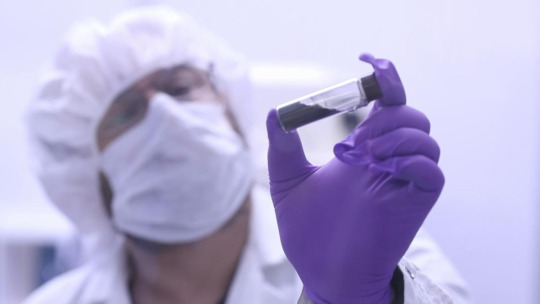
Neste quadro de vídeo, Jason Dworkin segura um frasco que contém parte da amostra do asteroide Bennu entregue à Terra pela missão OSIRIS-REx (Origins, Spectral Interpretation, Resource Identification, and Security – Regolith Explorer) da NASA em 2023. Dworkin é o cientista do projeto da missão no Goddard Space Flight Center da NASA em Greenbelt, Maryland. Crédito: NASA/James Tralie
0 notes
Text
A Very Important and Special Box of Rocks 🪨
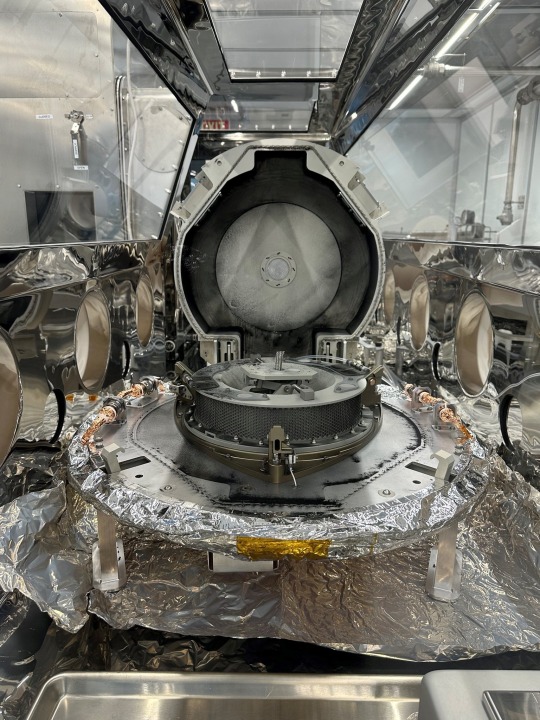
NASA’s OSIRIS-REx (Origins, Spectral Interpretation, Resource Identification and Security – Regolith Explorer) has been opened!
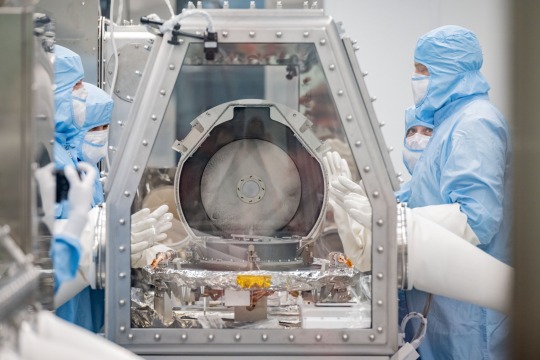
NASA scientists found black dust and debris on the avionics deck of the OSIRIS-REx science canister when the initial lid was removed today. The canister from the OSIRIS-REx sample return capsule was delivered to NASA’s Johnson Space Center in Houston on Sept. 25 after landing in the Utah desert on Sept. 24
With an array of team members on deck, scientists and engineers at Johnson will work together to complete the disassembly process and reveal the sample to the world in a special live broadcast event on Oct. 11 at 11 a.m. ET, streamed at NASA.gov/live
3 notes
·
View notes
Text

NASA lander to test vacuum cleaner on moon for sample collection
Among all the challenges of voyaging to and successfully landing on other worlds, the effective collection and study of soil and rock samples cannot be underestimated.
To quickly and thoroughly collect and analyze samples during next-generation Artemis moon missions and future journeys to Mars and other planetary bodies, NASA seeks a paradigm shift in techniques that will more cost-effectively obtain samples, conduct in situ testing with or without astronaut oversight, and permit real-time sample data return to researchers on Earth.
That's the planned task of an innovative technology demonstration called Lunar PlanetVac (LPV), one of 10 NASA payloads flying aboard the next lunar delivery for the agency's CLPS (Commercial Lunar Payload Services) initiative. LPV will be carried to the surface by Firefly Aerospace's Blue Ghost 1 lunar lander.
Developed by Honeybee Robotics, a Blue Origin company of Altadena, California, LPV is a pneumatic, compressed gas-powered sample acquisition and delivery system—essentially, a vacuum cleaner that brings its own gas. It's designed to efficiently collect and transfer lunar soil from the surface to other science instruments or sample return containers without reliance on gravity.
Secured to the Blue Ghost lunar lander, LPV's sampling head will use pressurized gas to stir up the lunar regolith, or soil, creating a small tornado. If successful, material from the dust cloud it creates then will be funneled into a transfer tube via the payload's secondary pneumatic jets and collected in a sample container.
The entire autonomous operation is expected to take just seconds and maintains planetary protection protocols. Collected regolith—including particles up to 1 cm in size, or roughly 0.4 inches—will be sieved and photographed inside the sample container with the findings transmitted back to Earth in real time.
The innovative approach to sample collection and in situ testing could prove to be a game-changer, said Dennis Harris, who manages the LPV payload for the CLPS initiative at NASA's Marshall Space Flight Center in Huntsville, Alabama.
"There's no digging, no mechanical arm to wear out requiring servicing or replacement—it functions like a vacuum cleaner," Harris said. "The technology on this CLPS payload could benefit the search for water, helium, and other resources and provide a clearer picture of in situ materials available to NASA and its partners for fabricating lunar habitats and launch pads, expanding scientific knowledge and the practical exploration of the solar system every step of the way."
Under the CLPS model, NASA is investing in commercial delivery services to the moon to enable industry growth and support long-term lunar exploration. As a primary customer for CLPS deliveries, NASA aims to be one of many customers on future flights. NASA's Marshall Space Flight Center in Huntsville, Alabama, manages the development of seven of the 10 CLPS payloads carried on Firefly's Blue Ghost lunar lander.
IMAGE: Lunar Planet Vac, or LPV, is one of 10 payloads set to be carried to the moon by the Blue Ghost 1 lunar lander in 2025. LPV is designed to efficiently collect and transfer lunar soil from the surface to other science and analysis instruments on the moon. Credit: Firefly Aerospace
3 notes
·
View notes
Text
NASAs Asteroid Bennu Sample Reveals Mix of Lifes Ingredients
Lee esta nota de prensa en español aquí. Studies of rock and dust from asteroid Bennu delivered to Earth by NASA’s OSIRIS-REx (Origins, Spectral Interpretation, Resource Identification and Security–Regolith Explorer) spacecraft have revealed molecules that, on our planet, are key to life, as well as a history of saltwater that could have served as the […] from NASA https://ift.tt/nDlRqzp
0 notes
Text
Measuring Moon Dust to Fight Air Pollution - NASA
New Post has been published on https://sunalei.org/news/measuring-moon-dust-to-fight-air-pollution-nasa/
Measuring Moon Dust to Fight Air Pollution - NASA
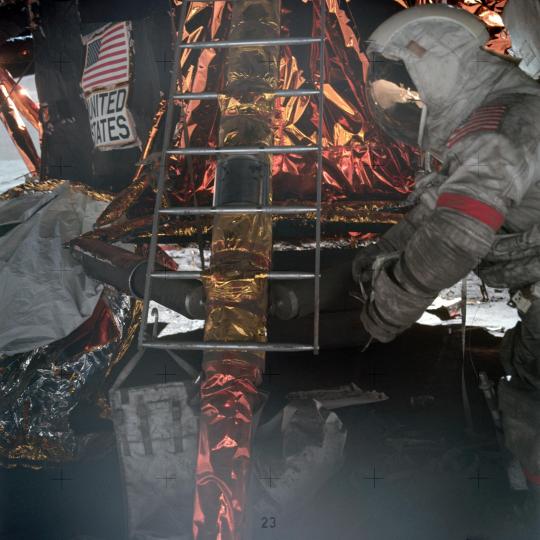
Moon dust, or regolith, isn’t like the particles on Earth that collect on bookshelves or tabletops – it’s abrasive and it clings to everything. Throughout NASA’s Apollo missions to the Moon, regolith posed a challenge to astronauts and valuable space hardware.
During the Apollo 17 mission, astronaut Harrison Schmitt described his reaction to breathing in the dust as “lunar hay fever,” experiencing sneezing, watery eyes, and a sore throat. The symptoms went away, but concern for human health is a driving force behind NASA’s extensive research into all forms of lunar soil.
The need to manage the dust to protect astronaut health and critical technology is already beneficial on Earth in the fight against air pollution.
Working as a contributor on a habitat for NASA’s Next Space Technologies for Exploration Partnerships (NextSTEP) program, Lunar Outpost Inc. developed an air-quality sensor system to detect and measure the amount of lunar soil in the air that also detects pollutants on Earth.
Originally based in Denver, the Golden, Colorado-based company developed an air-quality sensor called the Space Canary and offered the sensor to Lockheed Martin Space for its NextSTEP lunar orbit habitat prototype. After the device was integrated into the habitat’s environmental control system, it provided distinct advantages over traditional equipment.
Rebranded as Canary-S (Solar), the sensor is now meeting a need for low-cost, wireless air-quality and meteorological monitoring on Earth. The self-contained unit, powered by solar energy and a battery, transmits data using cellular technology. It can measure a variety of pollutants, including particulate matter, carbon monoxide, methane, sulfur dioxide, and volatile organic compounds, among others. The device sends a message up to a secure cloud every minute, where it’s routed to either Lunar Outpost’s web-based dashboard or a customer’s database for viewing and analysis.
The oil and gas industry uses the Canary-S sensors to provide continuous, real-time monitoring of fugitive gas emissions, and the U.S. Forest Service uses them to monitor forest-fire emissions.
“Firefighters have been exhibiting symptoms of carbon monoxide poisoning for decades. They thought it was just part of the job,” explained Julian Cyrus, chief operating officer of Lunar Outpost. “But the sensors revealed where and when carbon monoxide levels were sky high, making it possible to issue warnings for firefighters to take precautions.”
The Canary-S sensors exemplify the life-saving technologies that can come from the collaboration of NASA and industry innovations.
0 notes